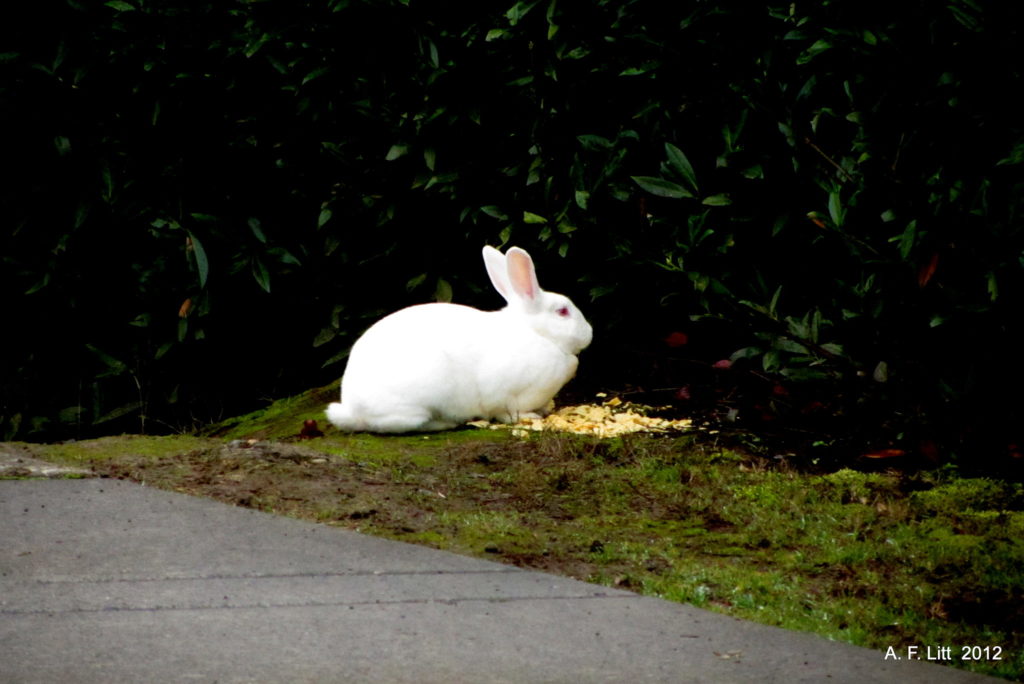The crisis of pet overpopulation and homelessness gets the most attention and recognition when it come to cats and dogs, but there are other animals who are also severely affected and in need of help. You may be surprised to learn that after cats and dogs, rabbits are the third most surrendered pet in most shelters in the United States. Unfortunately, unwanted rabbits are also often abandoned outdoors by the people who no longer want to care for them.
These unwanted, dumped community/feral rabbits were the inspiration for the book Discarded Rabbits, the Growing Crisis of Abandoned Rabbits and How We Can Help, by Lucile Moore with Debby Widolf. Through the book they hope to provide a useful and practical resource for those who wish to help abandoned rabbits, whether the person is involved in rescuing a large colony of feral rabbits or a single rabbit that has been abandoned in the neighborhood.
In order to learn more about these vulnerable animals and how they can be helped, I had a conversation with one of the book’s collaborators, Debby Widolf.

Dylan Forest: What is your background with rabbits, and how did you learn about rabbit rescue?
Debby Widolf: Twenty-five years ago I was given a rabbit to have as a “therapy animal” for the psychiatric hospital I worked at as an Occupational Therapist. Rosebud was not really interested in becoming a therapy rabbit, but I was smitten with her and committed. She came home with me and became my inspiration to learn everything I could about these beautiful creatures. Shortly after, I became an educator for the House Rabbit Society and later became a satellite chapter of the Colorado House Rabbit Society, answering the call to rescue locally abandoned rabbits, caring for them and finding adoptive homes.
In 2004 I was offered a position at Best Friends Animal Society as manager of their rabbit department in Kanab, UT. I never looked back and for the next nine years I managed the care of hundreds of rabbits, worked with staff vets, was part of a team for outreach, networking nationally, education, case management, adoption and participated in onsite assessments of hoarding/neglect cases, including the Reno Rabbit Rescue in 2006 of 1,250 backyard rabbits.
DF: Rabbits are frequently abandoned– why is this? What are your thoughts on how this problem could be addressed?
DW: As the popularity of domestic rabbits as pets soared the past twenty years or so, the downside was an exponential increase of rabbit abandonment. The actual number of dumped rabbits is essentially unknowable as most published figures for abandoned animals don’t list rabbits separately but lump them under “other,” but surrender numbers from shelters can give some idea of the numbers of rabbits that are given up. Studies in the U.S. found that rabbits were usually the third most surrendered pet.

The Rabbit Rescue Survey of 2010 reported that 36% of rabbits entering rescues in the UK are surrendered with the first six months of ownership, and 59% within the first year. The top reason for surrender was a child losing interest. A 2012 U.S. study of four U.S. shelters reported that most rabbits were given up because the owner did not want to take care of them. A researcher in Sweden found that the top three reasons for surrendering rabbits in that country were a lack of time, owners moving and allergies. Most surrenders are unaltered adults, so not wanting to pay for spay/neuter surgery may be another reason.
The rabbits’ status as a “starter pet” also contributes to the numbers of rabbits that are given up. Rabbits are often procured for a young child as a first pet, and then when the children become bored with the rabbit or find the rabbit requires more care than anticipated, the rabbit is either surrendered or neglected. Until the general public is better educated about rabbits they will continue to be displaced by more popular pets. Education is the key to reducing the number of abandoned rabbits, education at multiple levels – shelter workers, potential adopters, municipal authorities, etc. If people understood the nature and care of rabbits before they adopted, fewer would be surrendered. Low-cost spay/neuter programs for rabbits would also help reduce the number that are abandoned.
DF: Is rabbit rescue and sheltering substantially different from that of dogs and cats? Do you think most animal shelters are equipped to deal with rescuing rabbits?

DW: Yes, rabbit rescue and sheltering is very different from that of cats and dogs. To begin with, rabbits are prey animals, and this must be taken into consideration when capturing rabbits, for a rabbit can actually die of fright. Sheltering rabbits is different because they have different needs than dogs and cats.
Shelter personnel in multi-species shelters often have little or no knowledge of proper rabbit care. This is not to say that shelters and other animal organizations are uncaring; they do care, but the lack of knowledge hurts the efforts to save the lives of discarded rabbits. Because of this lack in training/knowledge about rabbits, many multi-species shelters are not equipped to deal with rescuing rabbits.
DF: In Discarded Rabbits, you say that sheltering is not enough to address the homeless rabbit crisis. Why is this, and what do you think would be a more effective solution?
DW: The ideal would be to rescue, shelter and eventually adopt all abandoned rabbits to the safe and loving homes that they so deserve. The reality is that this is not going to happen in the foreseeable future as there are not enough rescuers, not enough shelters and not enough people who appreciate the unique qualities of rabbits to adopt the huge numbers unwanted domestic rabbits. Many multi-species shelters do not accept rabbits, and those that do rarely allocate the same resources to rabbits as to dogs and cats. And since rabbits are not as popular a pet as dogs and cats this means rabbits don’t have as high an adoption rate, which translates to a higher cost per animal to maintain rabbits. Medical costs are also often higher for rabbits, who are considered an exotic animal. All these reasons contribute to why multi-species shelters are reluctant to take rabbits. Rabbit-only rescues and shelters are overwhelmed with calls to take unwanted rabbits and are often over-stretched for space and resources.

Since shelters are unable to deal with the numbers of abandoned rabbits, we must focus on reducing the number of rabbits who are abandoned. We must have more effective methods of educating the public about the consequences of dumping rabbits, and better prepare adopters for the realities of caring for rabbits. New strategies for placing, housing, and caring for the thousands of rabbits that need rescuing need to be implemented. By working collectively, we can help many of these unwanted, discarded rabbits.
DF: One side of rabbit rescue is dealing with entire feral rabbit colonies. Why are these colonies a problem, and what is the best way to address them?
The numbers of feral colonies of rabbits is on the increase, with colonies reported now in the majority of states in the U.S. and in many other countries around the globe. Despite harsh conditions, some dumped rabbits manage to survive on their own in dumpsites such as parks and subdivisions. Most often these dumped rabbits are unaltered and may breed, adding to the colony. People seeing the rabbits living on their own may then dump more at the same site, and the colony grows. If the rabbit colony persists long enough or becomes large enough, the rabbits may cause problems for local landowners, businesses or governments by destroying landscaping and even building foundations, and the rabbits’ presence may also draw predators to an area.

The best way to deal with these colonies will vary depending upon the particular colony situation, but will usually involve having experienced rabbit rescuers trap the rabbits, after which they are spayed and neutered and then relocated, either as a single colony or several smaller ones, where they can be monitored. That is best, but sadly the means used to control
these dumped and feral rabbits by property owners and municipalities are often not what many would consider humane. We need to remember that these rabbits did not choose to be abandoned and live wild. They were dumped by humans that are not held accountable for their ignorance and/or cruelty. But the rabbits, not the humans, suffer the consequences.
Discarded Rabbits: The Growing Crisis of Abandoned Rabbits and How We Can Help, by Lucile Moore with Debby Widolf, is available through many online book stores, such as Amazon.
Featured image: a feral rabbit, likely descended from abandoned pet rabbits. Image credit Teresa Trimm, CC BY-SA 2.0.





